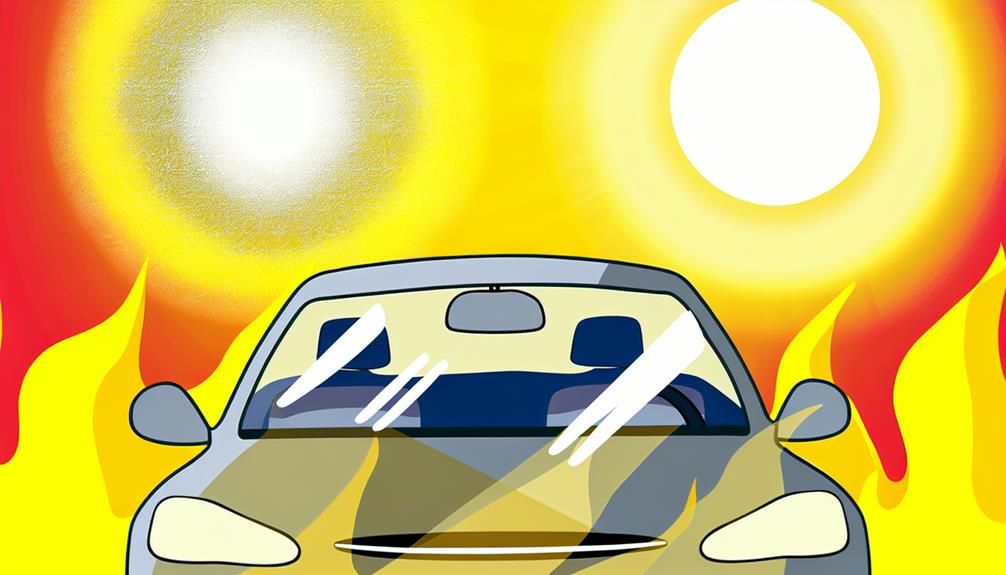As the weather warms up, the question of whether to crack your car windows becomes a pertinent consideration for many individuals. The decision involves a delicate balance between safety, comfort, and practicality.
While some advocate for increased airflow to prevent the car from turning into an oven, others caution against potential security risks or the entry of unwanted debris. These contrasting viewpoints make it essential to weigh the pros and cons carefully before making a final choice.
However, there are crucial factors beyond temperature regulation that deserve attention, making this discussion a nuanced and multifaceted one.
Key Takeaways
- Cracking car windows regulates temperature and enhances ventilation.
- Ensure pet safety by monitoring temperature and providing proper ventilation.
- Balance benefits of ventilation with risks like theft and weather exposure.
- Prioritize comfort and well-being by implementing expert-recommended measures.
Benefits of Cracking Car Windows
Cracking your car windows can provide ventilation and help regulate the temperature inside the vehicle while parked. By allowing fresh air to circulate, cracking the windows can prevent the interior from becoming stuffy and hot, especially during warm weather. Improved ventilation not only keeps the car more comfortable but also helps reduce odors that may build up inside.
Additionally, when it's humid outside, cracking the windows can help reduce condensation on the interior surfaces of the car, such as windows and windshield, which can obstruct visibility and create a damp environment. Reduced condensation is particularly beneficial for maintaining a clear view while driving and preventing mold or mildew from forming in the car.
It also aids in preserving the interior of the vehicle by minimizing moisture buildup that could lead to damage. Overall, cracking your car windows offers practical advantages in promoting air circulation, managing temperature, and preserving the vehicle's condition.
Risks of Cracking Car Windows
Opening car windows while parked comes with certain risks that drivers should be aware of to make informed decisions regarding ventilation. While cracking car windows can provide ventilation benefits, it's crucial to consider the potential dangers associated with this practice:
- Security Risks: Leaving windows open, even slightly, can make your vehicle an easier target for theft or vandalism.
- Weather Exposure: Cracking windows can lead to rainwater entering the car, potentially causing damage to the interior and electronics.
- Pest Intrusion: Insects or small animals might find their way inside the vehicle through open windows, creating a nuisance.
- Noise Pollution: Open windows can let in external noises, which may disturb occupants or make it harder to concentrate.
Understanding these risks is essential for drivers to balance the ventilation benefits of cracking car windows with the potential drawbacks. It's advisable to assess the environment, weather conditions, and security concerns before deciding to leave car windows open.
Impact on Interior Temperature
Exposure to external environmental factors through car windows can significantly influence the interior temperature of a vehicle. When the windows are cracked open slightly, it allows for a natural airflow that helps regulate the temperature inside the car. This can be particularly beneficial during hot weather, as it helps prevent the interior from becoming excessively hot and stuffy. By improving air circulation, cracking the windows can also aid in reducing condensation that may build up inside the vehicle, especially during colder weather or rainy days.
Maintaining a balanced interior temperature is essential for the comfort of passengers and can also prevent damage to items left inside the car. By cracking the windows, you can create a more pleasant environment, whether it's to cool down a hot car in the summer or to prevent fogging up of windows during humid conditions. Overall, this simple action can have a positive impact on the interior temperature and air quality within the vehicle.
Considerations for Pet Safety
When considering the safety and well-being of pets in a vehicle, it is crucial to take into account various factors that can impact their comfort and health.
- Pet Behavior: Understand your pet's behavior in the car. Some pets may feel anxious or stressed during car rides, which can affect their well-being. Ensure they are properly secured to prevent injuries or distractions while driving.
- Temperature Regulation: Pets are sensitive to temperature changes. In hot weather, a car can quickly become an oven, leading to heatstroke or dehydration in pets. On the other hand, cold temperatures can cause discomfort or hypothermia. Be mindful of the temperature inside the vehicle and adjust it accordingly.
- Ventilation: Proper ventilation is essential to ensure a constant supply of fresh air for your pet. Cracking the windows slightly can help regulate airflow and prevent the interior from becoming stuffy.
- Water and Food: Always carry an ample supply of water and food for your pets during car journeys. Hydration is crucial, especially in warm weather, to prevent dehydration. Similarly, providing food ensures they stay nourished and comfortable throughout the trip.
Expert Recommendations
To ensure the safety and well-being of pets during car journeys, experts recommend implementing specific measures that cater to their unique needs and comfort. Ventilation benefits are crucial when transporting pets in a vehicle. Experts suggest cracking the windows slightly to allow fresh air to circulate, preventing the interior from becoming too hot or stuffy. This simple step can help regulate the temperature inside the car and ensure that pets remain comfortable throughout the journey.
Safety concerns are paramount when it comes to traveling with pets in a car. Experts advise securing pets in appropriate carriers or using seat belts and harnesses designed for animals to prevent them from roaming freely inside the vehicle. This not only reduces distractions for the driver but also minimizes the risk of injury to the pet in the event of sudden stops or accidents.
Additionally, experts recommend never leaving pets unattended in a parked vehicle, especially in hot weather, as this can lead to heatstroke and other serious health issues. By following these expert recommendations, pet owners can prioritize their furry companions' safety and well-being during car rides.
Frequently Asked Questions
How Does Cracking Car Windows Affect the Build-Up of Humidity Inside the Car?
Cracking car windows allows for improved air circulation, reducing the build-up of humidity by facilitating the exchange of moist air with drier external air. This practice aids in condensation control, preventing fogging and maintaining a comfortable interior environment.
Can Cracking Car Windows Help Prevent Damage to the Interior From Extreme Temperature Fluctuations?
Promoting air circulation through cracked windows aids in temperature control, benefiting interior protection and ventilation. This preventive measure mitigates extreme temperature fluctuations, safeguarding your car's interior from potential damage while ensuring a comfortable environment.
Are There Any Specific Weather Conditions Where Cracking Car Windows Is Not Recommended?
During rainy days, cracking car windows may not be advisable as it can let water in. In snowy weather, condensation may form inside the car if windows are cracked, potentially leading to frost buildup and visibility issues.
How Does Cracking Car Windows Impact the Vehicle's Overall Energy Efficiency?
Improving energy efficiency in your vehicle hinges on optimal air circulation. Cracking windows aids in regulating interior temperature, reducing the need for excessive air conditioning or heating. This simple act can enhance overall vehicle efficiency and interior maintenance.
Are There Any Potential Legal Implications or Regulations Regarding Cracking Car Windows in Certain Areas or Situations?
Legal implications may arise from cracking car windows in restricted areas or situations due to safety concerns. Understanding local regulations is crucial to avoid fines or penalties. Prioritize safety by complying with applicable laws.
Conclusion
In conclusion, cracking your car windows can help regulate the interior temperature and improve ventilation. However, it is important to consider the potential risks, such as theft or weather damage.
As the saying goes, 'A stitch in time saves nine,' so taking precautions to ensure safety and comfort in your vehicle is essential. Expert recommendations suggest cracking windows slightly to prevent overheating, but always be mindful of the surroundings and potential hazards.

